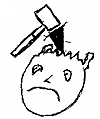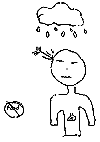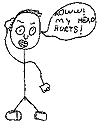 |
Children's Headache Drawings Help Neurologists |
 |
Children's Headache Drawings Help Neurologists |
|
March 21, 2002
Headaches are usually divided into two main types: Migraine and nonmigraine headaches have different treatments, so it is important for doctors to know what type of headache a person is suffering from. Headaches are a common reason why children visit the doctor, but it can be difficult to determine the type of headache in children because they may have trouble describing their pain. A new study published in the journal Pediatrics reports a new way for doctors to diagnose headaches: ask children to DRAW themselves having a headache! |
Young Artists The research team led by Dr. Carl E. Stafstrom asked 226 children (ages 4
to
19 years old) who complained of headaches to:
The research team led by Dr. Carl E. Stafstrom asked 226 children (ages 4
to
19 years old) who complained of headaches to:
"Please draw a picture of yourself having a headache. Where is your pain? What does your pain feel like? Are there any other changes or symptoms that come before or during your headache that you can show me in a picture?"
After the headache pictures were drawn, a neurologist examined each child
to diagnose the child's headache type (migraine or nonmigraine type).
The neurologist did NOT see the child's headache drawing before this
clinical examination. The headache drawings were
analyzed and classified
(migraine or nonmigraine type symptoms) by two doctors who did NOT know
the results of the clinical examination.
Drawings Tell the Headache StoryBased on the clinical examination, 130 children were diagnosed with migraine headaches and 96 children were diagnosed with nonmigraine headaches. Migraine headache drawings often showed the pounding or throbbing nature of a migraine. Some drawings of migraine headaches featured visual symptoms, upset stomachs, and nausea. Drawings of nonmigraine headaches did not show these features. Rather, children with nonmigraine headaches were drew pictures with objects tightening around their heads and with general sadness and pain. |
| Headache Drawings | |||
 Migraine Headache 9-yr-old boy |
 Migraine Headache 18-yr-old girl |
 Nonmigraine Headache 9-yr-old girl |
 Nonmigraine Headache 10-yr-old boy |
| (These four black and white drawings are from Stafstrom, C.E., Rostasy, K. and Minster, A, The usefulness of children's drawings in the diagnosis of headache. Pediatrics, 109:460-472, 2002, and are being used with the permission of C.E. Stafstrom.) | |||
 The researchers compared the diagnosis
from the clinical exam to the diagnosis based on the drawings. They found
that the clinical diagnosis and the drawing diagnosis for migraine
headaches MATCHED 93.1% of the time. Clinical and drawing diagnosis for
nonmigraine headaches MATCHED 82.7% of the time. The researchers found
that migraine headache drawings predicted a clinical diagnosis of a
migraine headache 87.1% of the time; nonmigraine headache drawings
predicted nonmigraine clinical diagnosis 90.6% of the time. Even the
drawings by young children (less than 8 years old) were accurate
predictors of the type of headache: the drawing diagnosis and clinical
examination diagnosis of migraine disagreed with each other only 5.6% of
the time. The researchers compared the diagnosis
from the clinical exam to the diagnosis based on the drawings. They found
that the clinical diagnosis and the drawing diagnosis for migraine
headaches MATCHED 93.1% of the time. Clinical and drawing diagnosis for
nonmigraine headaches MATCHED 82.7% of the time. The researchers found
that migraine headache drawings predicted a clinical diagnosis of a
migraine headache 87.1% of the time; nonmigraine headache drawings
predicted nonmigraine clinical diagnosis 90.6% of the time. Even the
drawings by young children (less than 8 years old) were accurate
predictors of the type of headache: the drawing diagnosis and clinical
examination diagnosis of migraine disagreed with each other only 5.6% of
the time.
Another Tool in the Doctor's Bag?This experiment demonstrates that children's drawings are capable of telling the difference between migraine and nonmigraine headaches. The researchers encourage doctors to add this method to their diagnositic tools. Perhaps the next time you visit the doctor's office, you will find paper, pencils and pens in the waiting room and the first question you will be asked is:
|
|
Reference and further information about headaches:
|
| GO TO: | Neuroscience In The News | Explore the Nervous System | Table of Contents |
![[email]](./gif/menue.gif) Send E-mail |
 Get Newsletter |
 Search Pages |